Sudan
Things to DO
Khartoum
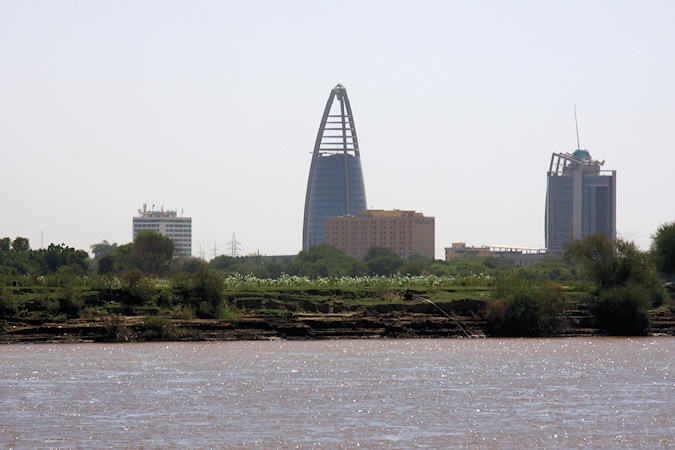 |
|||||
Sitting at the place where the waters of the Blue and White Niles meet before continuing their slow
progress to Egypt, Khartoum has a fantastic setting. It's a meeting point of the many ethnic groups that make
up Sudan, and to siy at a tea stall watching the world pass by is to watch a progression of tribes and
nationalities, from Arab, Dinka and Shilluk to Nibian, Beja and Fur.
Khartoum is actually three cities in one. The oldest part - Khartoum-proper - sits between the
confluence of the Blue and White Niles. On the west bank is Omdurman, the old Madhist capital and on
the north bank the semi-industrial city at Kharhoum-North.
Known locally as Al Mogran the Confluence of the Nile is one of Africa's geographical highlights.
From here you can look east along the fast and narrow Blue Nile streching to Ethiopia, turning south
you are faced with the White Nile, wide and lazt, exhausted by its passage from Lake Victoria through
the swamps of the Sudd.
The two Niles are distinct colours (or at least shades of muddy grey) on account of the silts they carry, and
you can seen the streams flow next to each other before mixing to complete the mighty river.
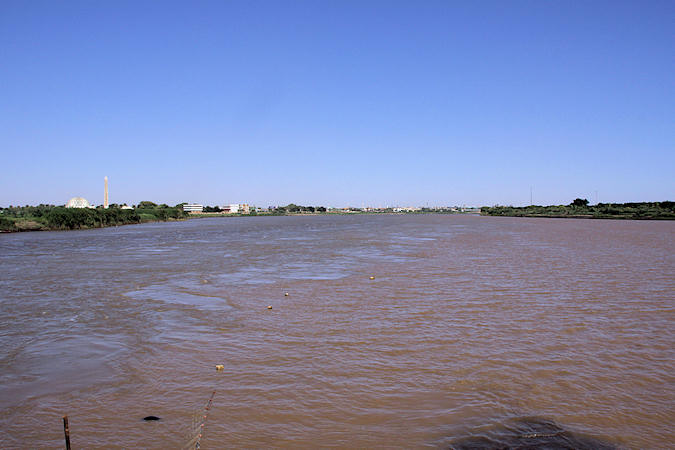 |
|||||
In other countries, a site like this would be heralded with signposts and vieuwpoints, but the Sudanese
are hapy to let things like this pass. In fact, the less attention drawn to it the better as far as the
security forces are concerned. Anyone pulling out a camera on the White Nile bridge overlooking the confluence
is likely to be approached by a security guard (probably dressead as a civilian). The bridge is regarded as
"stratigic", so photography (even with a permit) is expressly forbidden.
Strangly, the postcard sellers outside the main post office will happily sell you a snap of the bridge,
although the irony have gone unnoticed by the autorities.
The Roman Catholic Archdiocese of Khartoum has its origins in the mid 19th century and the
St Matthew's Cathedral was built over a 60-year period, starting in 1847.
It is an atractive cream building with fairytale turrents and a large rose window. services take place on
Sunday's and holy days.
National Museum
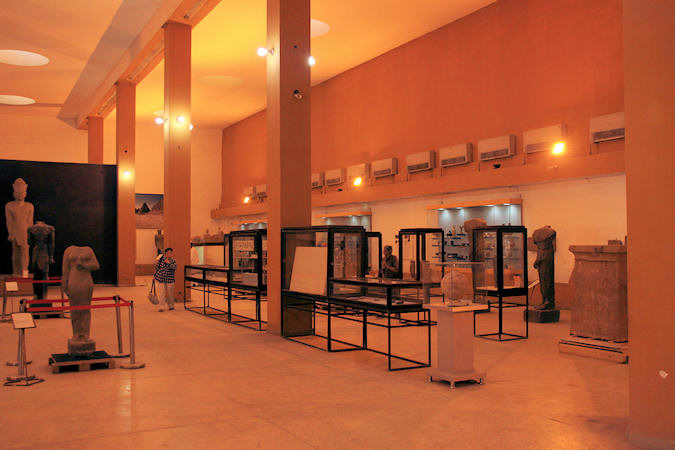 |
|||||
The National Museum holds many treasures osf Sudan's ancient and medieval past. The're well presented
and labelled and give a good narrative of Sudanese history
Spread out over two floors, the ground floor starts with Sudan's prehistory and covers the rise of Kerma
and Kush in great detail.
Kerma is particularly well represented through its famous pottery.
The Kushite displays show the wide variety of cultural exhange in play throughout the kingdom. (Hellenistic
as well as Egyptian).
The upstairs gallery holds the museums most unespected displays - frescoes from, Christian Nubia.
The style of the frescoes is distinctly Byzantine, reflecting Nubia's link with the Roman Empire in the east.
Most where painted between the 8th and 14th centuries and were taken from the Cathedral at Faras, now
submerged under Lake Nasser.
In the museum's ground there are tree remarkable temples rescued from the flood waters of Lake Nasser
in the 1960s and resurrected here
The Temple of Kumma was built largely during the reigns of the Queen Hatshepsut and the
Pharaohs Tuthmosis III and
Amenophis II, between 1473 and 1400 BC, within the Fortres of Kumma
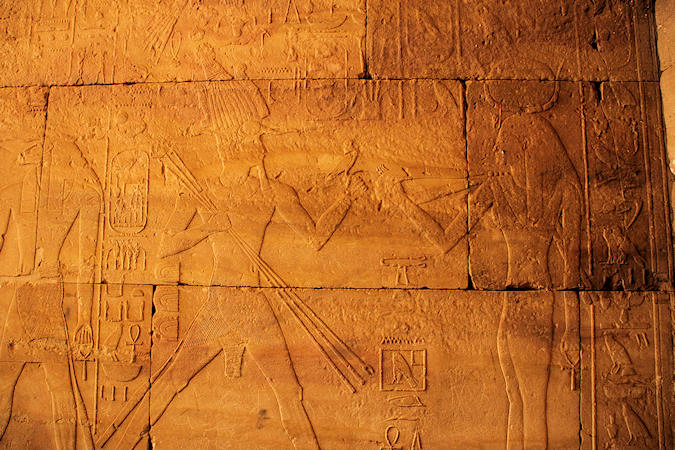 |
|||||
and was dedicated to the god Khnum, the chief deity of the cataract region.
Kumma was part of the series of fortresses, know as the Second Cataract Forts, built originally
by the Pharaohs of the Egyptian Middle Kingdom, probably to maintain control over movement up and down the
river, for both military and economic purpose. At this period, the effect frontier of Egyptian authority was
established at the Senna Cataract, the narrowest point of the Nile Valley in this region, some
60 kilometres south of Wadi Halfa. It was controlled by two fortresses, of which Kumma stood on the east bank
opposite the Fortres of Senna.
The Temple of Senna was built largely during the reign of the pharaoh Tuthmosis III within the
Fortress of Senna, and was dedicated to the Nubian god Dedwen and to the deified former Pharao
Sesostris III.
The susequent history of the temple is unclear. It was evidently of sinificance in the reigh of
Ramsses III (1186 - 1155 BC ) when the then Viceroy of Kush carved an inscription and was
still an important location in the 8th or 7th century BC, when an inscription and relief were carved for
the Kushite Queen Karimala
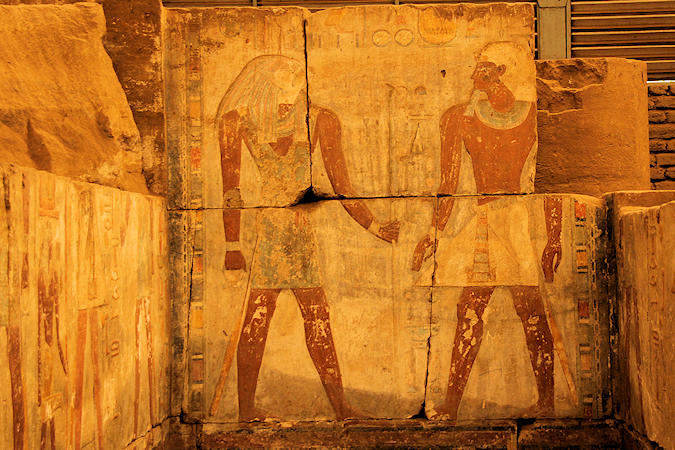 |
|||||
The Temple of Buhen was built in the fortress of Buhen, about 25km south of Aksha and was dedicated
to the falcon god Horus, Lord of Buhen.
The present temple was built on the remains of an earlier Middle Kingdom temple, beginning under
Tutmoses II (1492 - 1479 BC).
Queen Hatshepsut completed the building and is shown dedicating the temple to the god as co-regent
with Thutmosis III (1479-1425 BC).
After Thutmosis III assumed sole rule, some time following 1450 BC every representation of the Queen was
systematically erased from the temple reliefs, the figures and names of Thutmosis I and II being substituted.
Thutmosis III also extended the complex by building the forecourt, placing a triuphal stele within it, detailing
his victories in Libya and Syria.
The final alterations to the building took place during the XXVth Dynasty, probably under the Pharaoh
Taharqa (690-664 BC) who added a light structure to the front and widened the main doorways.
The temple continued in use into the early medieval period (ca 450 AD).
Omdurman
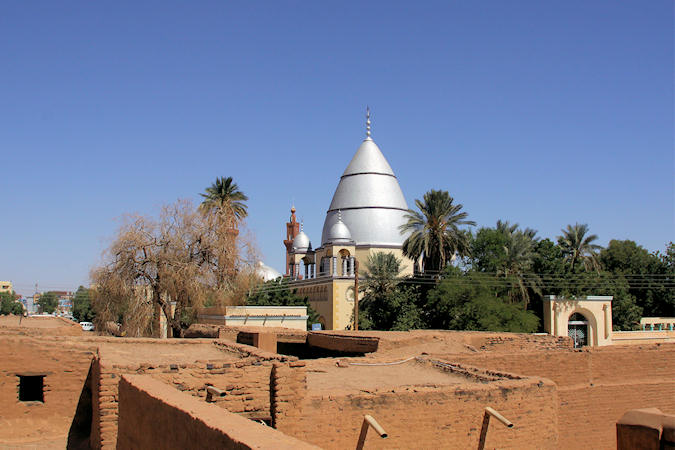 |
|||||
Muhammad Ahmad bin Abd Allah (August 12, 1845 – June 22, 1885) was a religious leader of the
Samaniyya-order in Sudan who, on June 29, 1881, proclaimed himself as the Mahdi or messianic
redeemer of the Islamic faith.
From his announcement of the Mahdiyya until the fall of Khartoum in January 1885, Muhammad Ahmad led a
successful military campaign against the Turco-Egyptian government of the Sudan.
Less then 5 months after the fall of Khartoum the Madhi died after a short illness.
A tomb with a glittering silver dome was raised in his honour and pelgrimage to the site was made incumbent on
all Sudanese, replacing the Hadj to Meca as one off the pillars of Islam.
Soon after the re-conquest of Sudan the British blew up the tomb to prevent it from becoming a railying point
for disaffected Sudanese.
The present tomb was rebuilt in 1947, presumably once the British had got over their fears of its symbolic power.
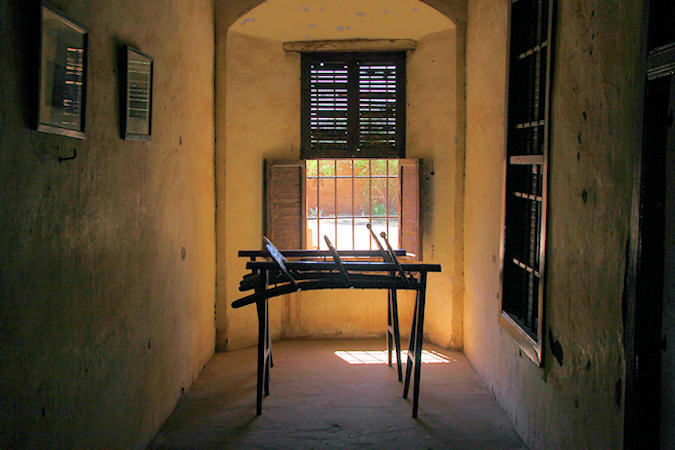 |
|||||
Across the street from the Madhi's Tombis the house of his successor, Khalifa Abdullah.
A low, two storey building with a series of linked courtyards, the house has been turned into a museum of the
Mahdiya period and is locally know as Beir al Kalifa.
The first rooms are dedicated to the Battle of Omdurman (september 2 1898) that saw the end of Madhist
rule to Sudan. There is a collection of rifles and spears obtained from the batterfield, as well as banners
and the patched robes known as jibbehs, worn by the Ansar.
The old muskets and crocodile-hide shields on display give a good illustration of the total inadequacy of
the Madhist army in the face of Britsh repeating rifles and Maxim guns.
The courtyards hold several interesting items - machine guns captured at the Battle of Sheikan, the
Cupola saved from the ruins of the original Mahdi's Tomb and the first car in Sudan, belonging to
the governor general.
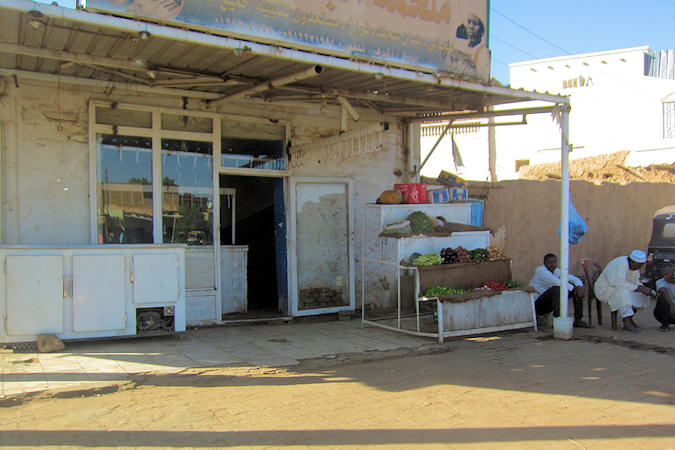 |
|||||
The souk in Ondurman is the largest in the country. the main part of the souk consists of endless alleys
and side streets lined with shops and stalls.
The buildings aren't particularly old but the sounds, smells and throngs of people capture the essence of the
bazar.
General Herbert Kitchener sailed up the Nile to Khartoum on his mission to defeat the Madhi at the
Battle of Omdurman.
His boat now lies on the west bank of the nile river about 300 meters south-east from the souk.
It's now mainly used by the local scholar's as a meeting point on their free hours.
Sheikh Hamed al-Nil was a 19th-century Sufi leader of the Quairiyah order tariga an his tomb is
the weekly focus for Omdurman most exciting sight - The Dancing and Chanting Dervishes.
The ceremony starts with a march across the cemetry to the tomb of the sheikh. It's an amazing sight as the dervishes
carry the green of the tariga, thier appearance a world away from
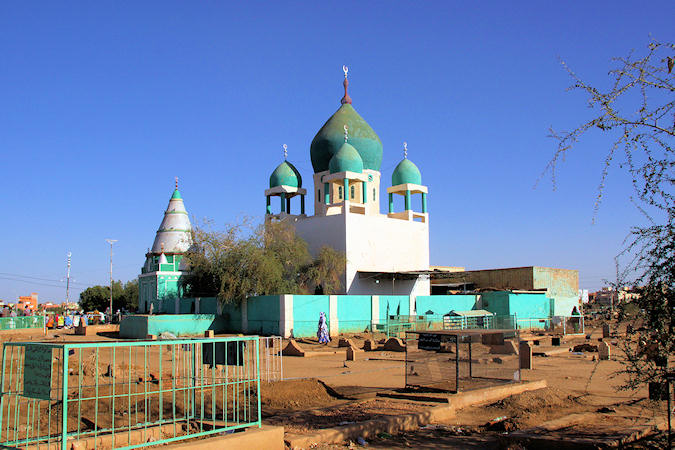 |
|||||
banner
the restrained
white robes of most Sudanese. Instead the jallabiyas are a crazy patchwork of green and red, often
topped off with with leopardskin, chunky beads and dreadlocks. As they march, they chant, accompanied by drums
and cymbals.
Outside the Tomb, a large open space is cleared fot the dervishes and the banner is raised for the ritual to
begin. The pace of the chanting picks up and the dervishes start to circle the clearing, bobbing and
clapping.
The purpose of the frenzy is a ritual called dhikr. The dhikr relies on the recitation of God's names
to help create a state of ecstatic abandon in which the adherent's heart can communicate directly with God.
This personal communication with God is central to Sufi practise.
As they march the dervishes repeatedly chant La Illaha Illallay meaning There is no God but Allah
the first line of the Muslim professi of faith. Around the edge of the circle other adherents clap and join
in the chanting creating a highly charfed and hypnotic atmosphere.